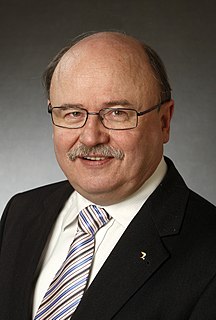The history of Estonia forms a part of the history of Europe. Humans settled in the region of Estonia near the end of the last glacial era, beginning from around 8500 BC. Before German crusaders invaded in the early 13th century, proto-Estonians of ancient Estonia worshipped spirits of nature. Starting with the Northern Crusades in the Middle Ages, Estonia became a battleground for centuries where Denmark, Germany, Russia, Sweden and Poland fought their many wars over controlling the important geographical position of the country as a gateway between East and West.

The Singing Revolution is a commonly used name for events between 1987 and 1991 that led to the restoration of the independence of Estonia, Latvia and Lithuania. The term was coined by an Estonian activist and artist, Heinz Valk, in an article published a week after the 10–11 June 1988, spontaneous mass evening singing demonstrations at the Tallinn Song Festival Grounds.

Konstantin Päts was the most influential politician of interwar Estonia, and served five times as the country's head of government. He was one of the first Estonians to become active in politics and started an almost 40-year political rivalry with Jaan Tõnisson, first through journalism with his newspaper Teataja, later through politics. He was condemned to death during the 1905 Revolution, but managed to flee first to Switzerland, then to Finland, where he continued his literary work. He returned to Estonia, but had to spend time in prison in 1910–1911.

Igor Gräzin is an Estonian politician. He is serving as a Member of Parliament in Riigikogu, the Estonian Parliament, and won another term in the 2011 parliamentary election. Gräzin is a charter member of the Estonian Reform Party which carried a sweeping victory in these elections.

Lagle Parek is an Estonian politician. She served as the Minister of the Interior in the first post-Soviet occupation government, led by the prime minister Mart Laar.

The Estonian Soviet Socialist Republic, also known as Soviet Estonia or Estonia was an unrecognized republic of the Soviet Union, administered by a subordinate of the Soviet government. The ESSR was initially established on the territory of the Republic of Estonia on 21 July 1940, following the invasion of Soviet troops on 17 June 1940, and the installation of a puppet government backed by the Soviet Union, which declared Estonia a Soviet constituency. The Estonian SSR was subsequently incorporated into the Soviet state on 9 August 1940. The territory was occupied by Nazi Germany from 1941 to 1944 and administered as a part of Reichskommissariat Ostland.
Parliamentary elections were held in Estonia on 14 and 15 July 1940 alongside simultaneous elections in Latvia and Lithuania. The elections followed the Soviet occupation of the three countries, and were rigged. The Estonian Working People's Union, a Communist front group, was the only party allowed to run, and won all 80 seats with 92.8% of the vote. The newly elected People's Parliament declared the Estonian SSR on 21 July and requested admission to the Soviet Union the following day. The request was approved by the Soviet government on 6 August.
Elections to the Supreme Soviet of the Estonian SSR were held on 16 February 1947. They were the first elections since the Estonian SSR was declared on 21 July 1940. The Bloc of Communists and Non-Party Candidates was the only party able to contest the elections, and won all 100 seats. Elected members included Joseph Stalin, Vyacheslav Molotov and Andrei Zhdanov.
Elections to the Supreme Soviet of the Estonian SSR were held on 27 February 1955. The Bloc of Communists and Non-Party Candidates was the only party able to contest the elections, and won all 125 seats.
Elections to the Supreme Soviet of the Estonian SSR were held on 15 March 1959. The Bloc of Communists and Non-Party Candidates was the only party able to contest the elections, and won all 125 seats.
Elections to the Supreme Soviet of the Estonian SSR were held on 17 March 1963. The Bloc of Communists and Non-Party Candidates was the only party able to contest the elections, and won all 178 seats.
Elections to the Supreme Soviet of the Estonian SSR were held on 19 March 1967. The Bloc of Communists and Non-Party Candidates was the only party able to contest the elections, and won all 178 seats.
Elections to the Supreme Soviet of the Estonian SSR were held on 13 June 1971. The Bloc of Communists and Non-Party Candidates was the only party able to contest the elections, and won all 183 seats.
Elections to the Supreme Soviet of the Estonian SSR were held on 15 June 1975. The Bloc of Communists and Non-Party Candidates was the only party able to contest the elections, and won all 200 seats.
Elections to the Supreme Soviet of the Estonian SSR were held on 24 February 1980. The Bloc of Communists and Non-Party Candidates was the only party able to contest the elections, and won all 285 seats.
Elections to the Supreme Soviet of the Estonian SSR were held on 24 February 1985. The Bloc of Communists and Non-Party Candidates was the only party able to contest the elections, and won all 285 seats.
Illar Hallaste was an Estonian cleric, politician, lawyer, and businessman, most notable for being a voter for the Estonian restoration of Independence.

Ülo Nugis was an Estonian politician and economist. As Speaker of the Supreme Council of Estonia on 20 August 1991, he presided over the Supreme Council's historic session when it voted for the restoration of Estonia’s national independence from the Soviet Union.








